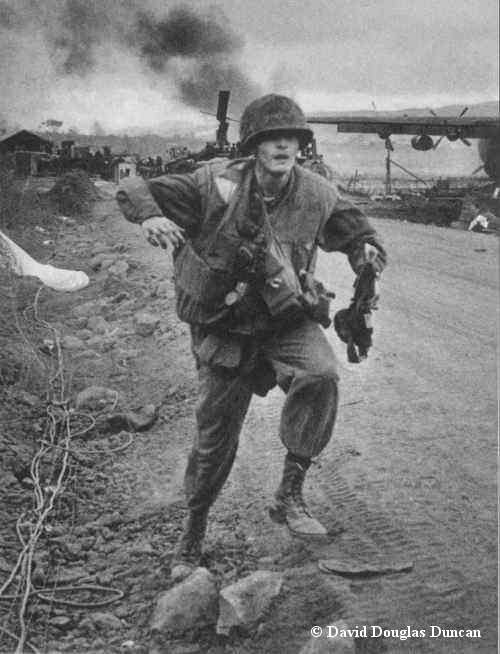 Fox
holes and trenches always seemed miles away - on the other side of the
world - when rocket barrages began crashing upon the Marines at Khe Sanh.
Each man counted two seconds from the first guttural approaching moan until
another drab chunk of their perimeter blew apart . . . hopefully not where
he was lying motionless, trying to disappear, too rigid to breathe.
North Vietnamese gunners, who were controlled by always-moving ridge top
observers, rarely missed hitting something or someone, with every salvo
fired. So the 26th Marines lived like prairie dogs, in and out of
their vast colony of bunkers. On tough days five or six 122mm rockets
hurtled in every minute. It took a special sort of man to stand quietly
during such an attack while guiding other men to cover.
Fox
holes and trenches always seemed miles away - on the other side of the
world - when rocket barrages began crashing upon the Marines at Khe Sanh.
Each man counted two seconds from the first guttural approaching moan until
another drab chunk of their perimeter blew apart . . . hopefully not where
he was lying motionless, trying to disappear, too rigid to breathe.
North Vietnamese gunners, who were controlled by always-moving ridge top
observers, rarely missed hitting something or someone, with every salvo
fired. So the 26th Marines lived like prairie dogs, in and out of
their vast colony of bunkers. On tough days five or six 122mm rockets
hurtled in every minute. It took a special sort of man to stand quietly
during such an attack while guiding other men to cover.
The hoarse-voiced nine foot rockets were fired in salvos of three; a habit so fixed that the 26th Marines waited for the third to explode - then made their breaks to rush wounded men to the nearest aid station, or search hastily for better cover; or wander dazed subconsciously seeking escape; or race to the edge of the runway for other casualties being medevaced to the suddenly overburdened doctors . . . with the chopper pilots typically flying in through the worst of the enemy firestorms.
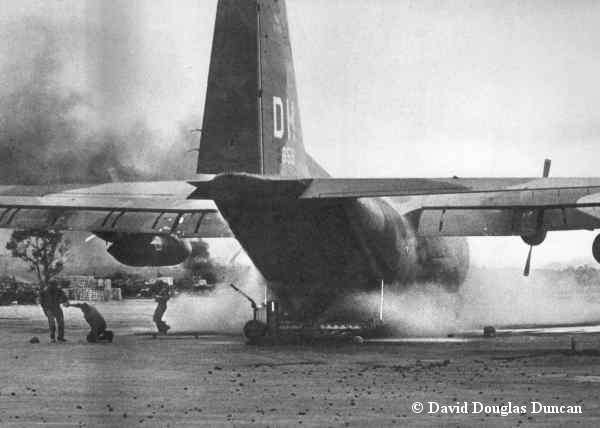 Mortar
salvos followed the rockets; one exploding here under a just-landed C-130
(probably the one photographed by 1stLt. Peter Dunev), and felling
a crewman who is seen being assisted by another. Of all the thousands
of men whose lives were constantly in danger at Khe Sanh, the helicopter
pilots (who could fly in high and then make a tight spiraling semi-autorotation
within the perimeter of Khe Sanh to a landing) realized no one risked them
more casually or with greater frequency than the workhorse crews who barreled
the giant C-130 transports in at treetop level to shoot landings on the
metal-slabbed airstrip.
Mortar
salvos followed the rockets; one exploding here under a just-landed C-130
(probably the one photographed by 1stLt. Peter Dunev), and felling
a crewman who is seen being assisted by another. Of all the thousands
of men whose lives were constantly in danger at Khe Sanh, the helicopter
pilots (who could fly in high and then make a tight spiraling semi-autorotation
within the perimeter of Khe Sanh to a landing) realized no one risked them
more casually or with greater frequency than the workhorse crews who barreled
the giant C-130 transports in at treetop level to shoot landings on the
metal-slabbed airstrip.
Enemy ambushes and monsoon cloudbursts had cut Colonial Highway 9, the only road winding back through the mountains and rain forest, soon after the 26th Marines were ordered to Khe Sanh. Unarmed, the massive planes were under machine-gun fire from the moment they first lowered their wheels and began their ruler-straight approach. There was no other way: the fortress had but one runway. North Vietnamese sharpshooters simply set up their machine guns and waited for the Yank fliers.
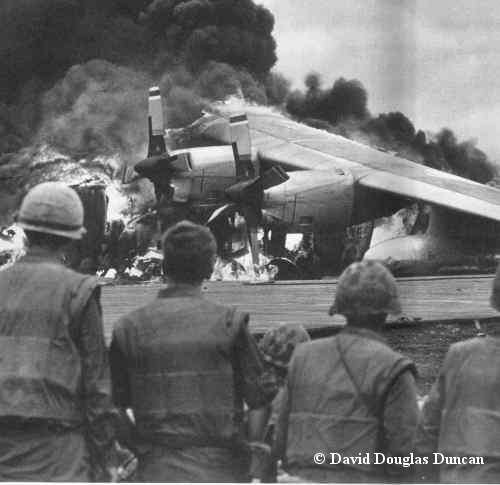 This
loaded C-130 of VMGR-152, machine-gunned during its final seconds in the
air, skidded the length of the runway in a fireball of its own cargo -
aviation fuel - and exploded, killing one crewman and five passengers.
Struggling to reach them - and to clear the runway - rescue teams fought
the holocaust with foam. One rescuer had to be saved himself when
overcome by smoke. Rescuers edged their fire trucks directly against
the flaming plane, aiming high-pressure foam at the inferno's heart.
They ignored the danger of the other fuel tanks bursting into geysers of
burning aviation fuels. The fire chief without even a mask, had tried
to enter the cabin, but its roof collapsed just ahead of him. It
had been hopeless from the start. Finally, the rescue team chief,
never having found time to put on his mask, stood exhausted by the hulk
of the plane. And helpless tears streaked down his face.
This
loaded C-130 of VMGR-152, machine-gunned during its final seconds in the
air, skidded the length of the runway in a fireball of its own cargo -
aviation fuel - and exploded, killing one crewman and five passengers.
Struggling to reach them - and to clear the runway - rescue teams fought
the holocaust with foam. One rescuer had to be saved himself when
overcome by smoke. Rescuers edged their fire trucks directly against
the flaming plane, aiming high-pressure foam at the inferno's heart.
They ignored the danger of the other fuel tanks bursting into geysers of
burning aviation fuels. The fire chief without even a mask, had tried
to enter the cabin, but its roof collapsed just ahead of him. It
had been hopeless from the start. Finally, the rescue team chief,
never having found time to put on his mask, stood exhausted by the hulk
of the plane. And helpless tears streaked down his face.
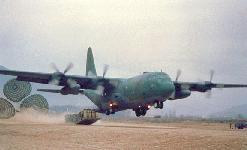 From
this point on the C-130s and C-123s were, by in large, prohibited from
landing on the airstrip. However, the Air Force had a delivery system
known as LAPES (Low Altitude Parachute Extraction System) that was used
to deliver supplies and ammunition to Khe Sanh. This tactic was a
low level self-contained system capable of delivering heavy loads into
an area where landing was not feasible from an optimum aircraft wheel altitude
of 5 to 10 feet above the ground. Their load, which could consist
of two pallets with a total weight of up to 38,000 pounds were resting
on roller bearing tracks in the floor of the aircraft. Small parachutes
were deployed at the proper time to jerk the cargo from the aircraft to
land on the runway and theroetically come to rest in a short distance.
Whether from timing mistakes in deploying the parachutes, improper altitude
release or simply the congested nature of Khe Sanh, these deliveries were
ceased after one eight-ton load of lumber skidded into a mess hall off
the end of the runway crushing three Marines to death. Another LAPES
delivery of artillery rounds plowed through a bunker, killing two Marines.
From
this point on the C-130s and C-123s were, by in large, prohibited from
landing on the airstrip. However, the Air Force had a delivery system
known as LAPES (Low Altitude Parachute Extraction System) that was used
to deliver supplies and ammunition to Khe Sanh. This tactic was a
low level self-contained system capable of delivering heavy loads into
an area where landing was not feasible from an optimum aircraft wheel altitude
of 5 to 10 feet above the ground. Their load, which could consist
of two pallets with a total weight of up to 38,000 pounds were resting
on roller bearing tracks in the floor of the aircraft. Small parachutes
were deployed at the proper time to jerk the cargo from the aircraft to
land on the runway and theroetically come to rest in a short distance.
Whether from timing mistakes in deploying the parachutes, improper altitude
release or simply the congested nature of Khe Sanh, these deliveries were
ceased after one eight-ton load of lumber skidded into a mess hall off
the end of the runway crushing three Marines to death. Another LAPES
delivery of artillery rounds plowed through a bunker, killing two Marines.
It seemed astonishing any aircraft made it at all. Yet they did, and the Marine helicopters and the fixed wing transports such as the C-130, kept the Marines at Khe Sanh fed and armed, evacuated their wounded, and filled the 26th Marines with hope that one day they too might be on the next big beautiful transport headed out to "The World", and still alive.
Clouds sank lower upon Khe Sanh and its airfield. Clouds dank and dreary and filled with winter chill. Clouds that fogged and blinded the eyes of those enemy rocket and mortar and artillery spotters who looked down upon the besieged garrison; lonely gunners who had called their fire with unvarying precision. So, the cold, wind-borne clouds were blessed by the Marines.
Night was near when two great birds beat through the clouds to squat
upon the runway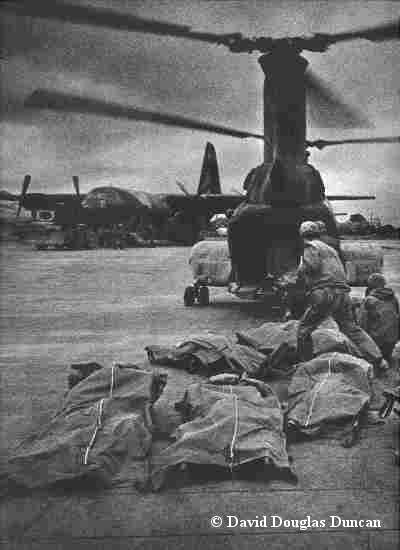 - two gaping-beaked, potbellied prehistoriic birds: messengers come now
to carry off the fallen men of the day's battle. Men joining those
other men killed in all other wars.
- two gaping-beaked, potbellied prehistoriic birds: messengers come now
to carry off the fallen men of the day's battle. Men joining those
other men killed in all other wars.
Then they were gone and it was night.
Information provided by:
War Without Heros, Harper and Row 1970
Federation of American Scientists
David Douglas Duncan
Bruce M. Geiger, former 1stLt. USMCR
Click here for a reflection on Khe Sanh 30 years later
Back Browser or Album Index or Home